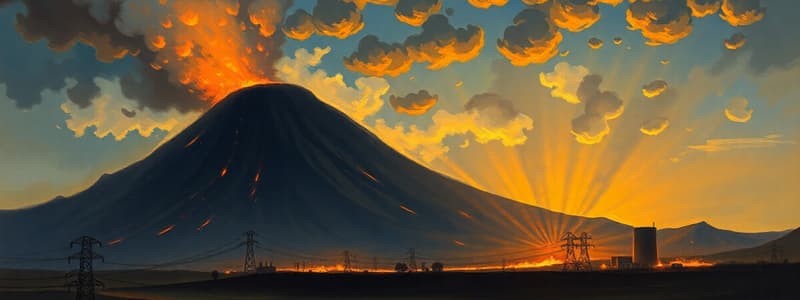Podcast
Questions and Answers
What is a significant safety concern associated with nuclear energy?
What is a significant safety concern associated with nuclear energy?
- Availability of renewable resources
- Public acceptance of energy policies
- Radiation safety if infrastructure fails (correct)
- Cost of nuclear fuel
Nuclear waste disposal is a simple and easily manageable process.
Nuclear waste disposal is a simple and easily manageable process.
False (B)
What natural hazards pose the greatest threat to nuclear facilities?
What natural hazards pose the greatest threat to nuclear facilities?
Earthquakes and tsunamis
Innovative energy production methods are necessary to address the challenges posed by __________ in nuclear energy.
Innovative energy production methods are necessary to address the challenges posed by __________ in nuclear energy.
Match the following nuclear energy concerns with their descriptions:
Match the following nuclear energy concerns with their descriptions:
What natural hazard significantly impacts energy infrastructure and production due to volcanic ash?
What natural hazard significantly impacts energy infrastructure and production due to volcanic ash?
The 2010 eruption of Eyjafjallajökull in Iceland had no impact on global energy transportation systems.
The 2010 eruption of Eyjafjallajökull in Iceland had no impact on global energy transportation systems.
Name the volcano in Indonesia known for its frequent eruptions that threaten energy production.
Name the volcano in Indonesia known for its frequent eruptions that threaten energy production.
One strategy for mitigating the effects of natural hazards is the implementation of ______ systems.
One strategy for mitigating the effects of natural hazards is the implementation of ______ systems.
Match the following energy sources with their characteristics:
Match the following energy sources with their characteristics:
What is one of the key factors in mitigating the impact of events like volcanic eruptions on energy transmission?
What is one of the key factors in mitigating the impact of events like volcanic eruptions on energy transmission?
Renewable energy sources are always reliable and consistent.
Renewable energy sources are always reliable and consistent.
Identify one method used to predict the timing and intensity of a natural hazard.
Identify one method used to predict the timing and intensity of a natural hazard.
Flashcards
Nuclear Safety Concerns
Nuclear Safety Concerns
Potential hazards arise from damaged infrastructure, leading to radiation leaks and containment failures, especially during natural disasters like earthquakes and tsunamis.
Nuclear Waste Disposal
Nuclear Waste Disposal
Finding safe, long-term storage for nuclear waste is a significant challenge, especially in areas prone to natural disasters.
Energy Alternatives
Energy Alternatives
Finding alternative energy sources or improved nuclear reactor designs are essential because of nuclear waste and natural disaster risks.
Natural Disasters
Natural Disasters
Signup and view all the flashcards
Nuclear Energy
Nuclear Energy
Signup and view all the flashcards
Natural Hazards Impact on Energy
Natural Hazards Impact on Energy
Signup and view all the flashcards
Mount Merapi's Threat
Mount Merapi's Threat
Signup and view all the flashcards
2010 Iceland Eruption Impact
2010 Iceland Eruption Impact
Signup and view all the flashcards
Natural Hazard Prediction
Natural Hazard Prediction
Signup and view all the flashcards
Hazard Prevention Strategies
Hazard Prevention Strategies
Signup and view all the flashcards
Energy Transmission Vulnerability
Energy Transmission Vulnerability
Signup and view all the flashcards
Fossil Fuels and Extraction Risks
Fossil Fuels and Extraction Risks
Signup and view all the flashcards
Renewable Energy Intermittency
Renewable Energy Intermittency
Signup and view all the flashcards
Study Notes
Energy and Natural Hazards
- Natural hazards significantly affect energy infrastructure and production.
- Volcanic ash disrupts air travel and power generation, causing billions in damage.
Mount Merapi eruption
- Mount Merapi's frequent eruptions threaten energy production and infrastructure.
- Ash clouds contaminate water sources and disrupt agriculture, impacting energy access.
Iceland volcano 2010
- The 2010 Eyjafjallajökull eruption halted European air travel.
- Volcanic ash plumes blocked airspace, costing airlines billions, impacting global energy transport.
The 3 Ps for Natural Hazards
- Prediction: Crucial to know a hazard's timing and intensity.
- Improved monitoring (seismic sensors, satellite imagery) enhances understanding.
- Prevention: Mitigation strategies are vital (earthquake-resistant buildings, land-use planning, early warning systems).
- Robust infrastructure withstanding natural forces is critical for mitigation.
- Protection: Emergency response, evacuation, and disaster relief are essential.
- Securing energy production and distribution systems is a key area.
Energy Consumption and Production
- Fossil Fuels: High demand leads to continued extraction.
- Extraction raises environmental concerns and risk in hazard-prone areas.
- Renewable Energy: Solar and wind power are growing but intermittent.
- Reliable energy solutions and advanced storage are needed for integration into grids.
- Energy Transmission: Transmission lines are susceptible to natural events.
- Severe weather, volcanic eruptions, and other hazards can damage infrastructure, cutting off power.
- Strengthening transmission grids and resilience measures are essential.
Nuclear Energy
- Safety Concerns: Nuclear energy faces radiation safety risks from damaged infrastructure.
- Earthquakes and tsunamis threaten nuclear facilities, requiring strong design and safety protocols.
- Waste Disposal: Long-term nuclear waste disposal is a major challenge.
- Natural hazard regions are not ideal waste disposal sites, adding complexity.
- Alternatives: Innovative energy production and transmission methods are vital.
- Resilient nuclear reactor designs to lessen risks amidst disasters are also crucial.
Studying That Suits You
Use AI to generate personalized quizzes and flashcards to suit your learning preferences.




